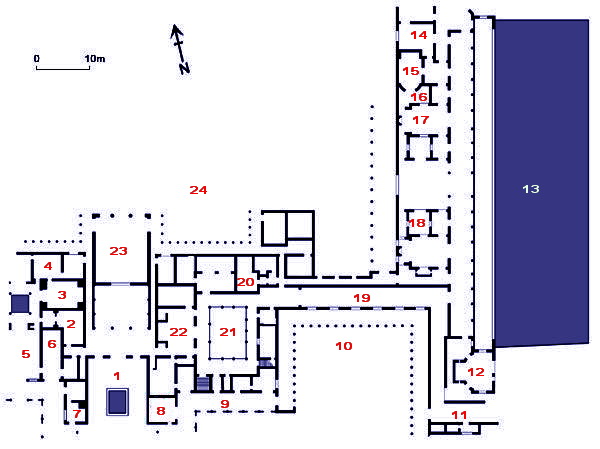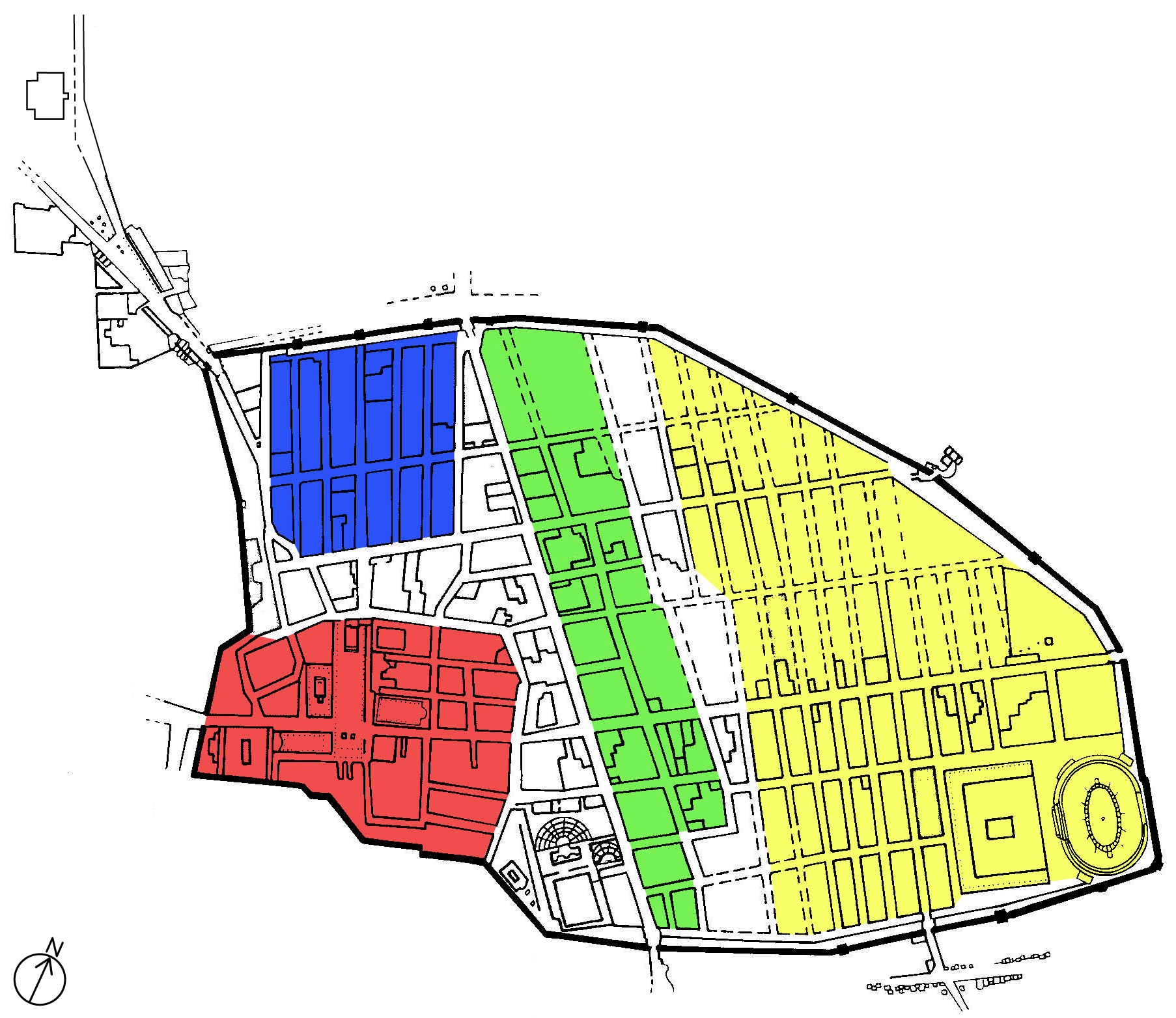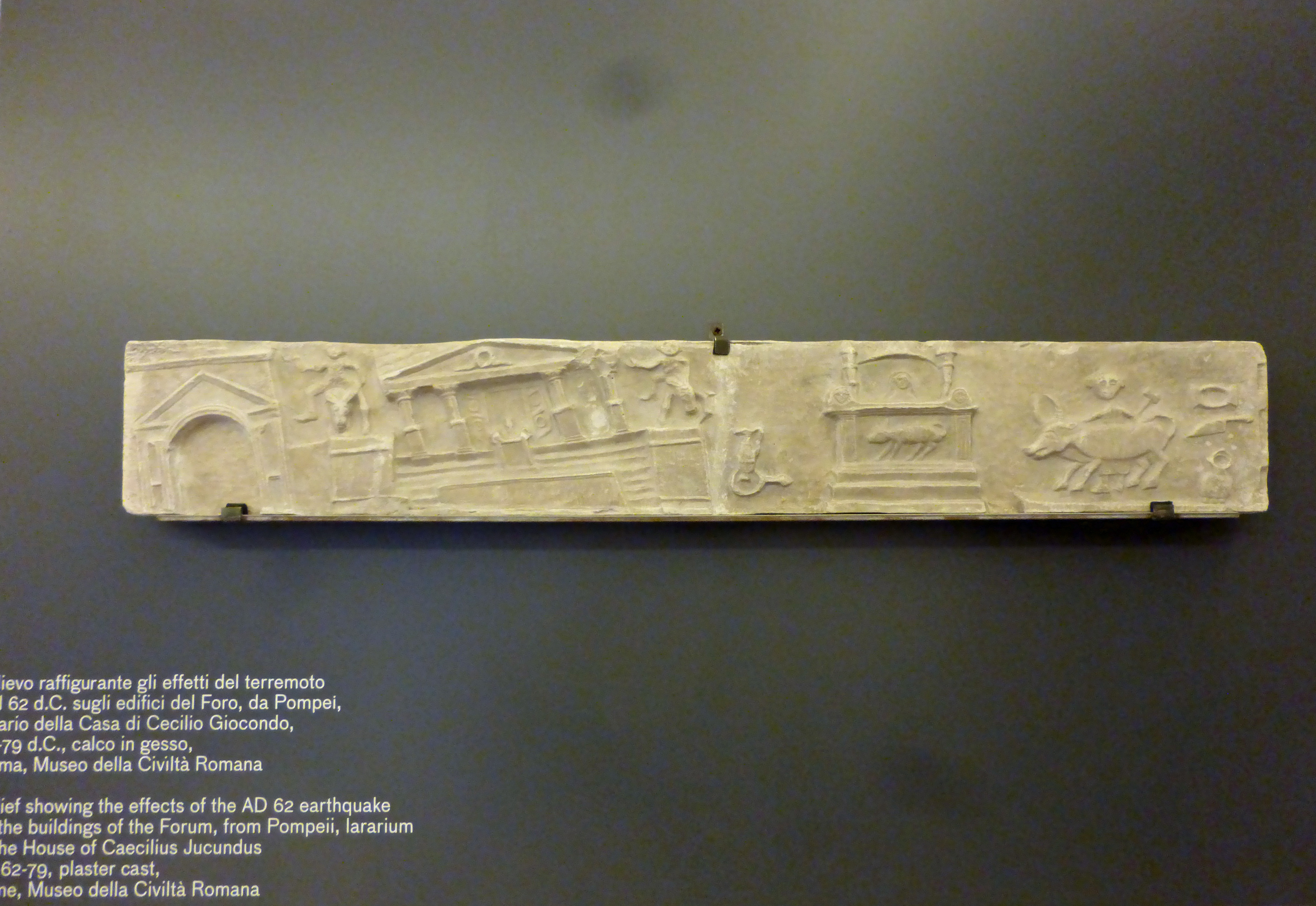|
Oplontis
Oplontis is an ancient Roman archaeological site, located in the town of Torre Annunziata, south of Naples in the Campania region of southern Italy. The excavated site comprises two Roman villas, the best-known of which is Villa A, the so-called Villa Poppaea. Like the nearby towns of Pompeii and Herculaneum, Oplontis was buried in ash during the volcanic eruption of Mount Vesuvius in 79 AD. However, the force of the eruption was even stronger than at these cities as not only roofs collapsed, but walls and columns were broken and pieces thrown sideways. History and excavations The town of Oplontis probably developed under where Torre Annunziata stands today. Excavations have revealed buildings particularly on the east and west sides of the town, the eastern one in the immediate vicinity of Villa A and the other almost at its boundary with Torre del Greco. It is thought that in antiquity, as elsewhere (e.g. at Herculaneum and Stabiae), luxury residential villas like Villa A l ... [...More Info...] [...Related Items...] OR: [Wikipedia] [Google] [Baidu] |
Villa Poppaea
The Villa Poppaea is an ancient luxurious Roman seaside villa (''villa maritima'') located in Torre Annunziata between Naples and Sorrento, in Southern Italy. It is also called the Villa Oplontis or Oplontis Villa A as it was situated in the ancient Roman town of Oplontis. It was buried and preserved in the eruption of Vesuvius in 79 AD, like the nearby cities of Herculaneum and Pompeii, about below modern ground level. The quality of the decorations and construction suggests that it was owned by the Emperor Nero and a pottery shard bearing the name of a freedman of Poppaea Sabina, the second wife of the emperor Nero was found at the site, which suggests the villa may have been her residence when she was away from Rome and which gives it its popular name. It was sumptuously decorated with fine works of art. Its marble columns and capitals mark it out as being especially luxurious compared with others in this region which usually had stuccoed brick columns. Many artifacts f ... [...More Info...] [...Related Items...] OR: [Wikipedia] [Google] [Baidu] |
Pompeii
Pompeii ( ; ) was a city in what is now the municipality of Pompei, near Naples, in the Campania region of Italy. Along with Herculaneum, Stabiae, and Villa Boscoreale, many surrounding villas, the city was buried under of volcanic ash and pumice in the eruption of Mount Vesuvius in 79 AD. Largely preserved under the ash, Pompeii offers a unique snapshot of Culture of ancient Rome, Roman life, frozen at the moment it was buried, as well as insight into ancient urban planning. It was a wealthy town of 10,000 to 20,000 residents at the time it was destroyed. It hosted many fine public buildings and luxurious private houses with lavish decorations, furnishings and artworks, which were the main attractions for early excavators; subsequent excavations have found hundreds of private homes and businesses reflecting various architectural styles and social classes, as well as numerous public buildings. Organic remains, including wooden objects and human bodies, were interred in the as ... [...More Info...] [...Related Items...] OR: [Wikipedia] [Google] [Baidu] |
Torre Annunziata
Torre Annunziata (; ) is a (municipality) in the Metropolitan City of Naples, in the Italian region of Campania. It is located on the Gulf of Naples, at the foot of Mount Vesuvius. History The city was destroyed in the Vesuvius eruption of 79 AD and in 1631. The city was once the seat of important ironwork (Deriver, Dalmine), food processing and pasta industries. Today industries still active include naval, armament and pharmaceutical ones. The archaeological site of Oplonti is a UNESCO World Heritage Site since 1997. Geography Torre Annunziata borders with the municipalities of Boscoreale, Boscotrecase, Castellammare di Stabia, Pompei, Torre del Greco and Trecase. Trains from Torre Annunziata Centrale rail station operate to Naples and Pompei.The TrainlineTrains to Torre Annunziata Centrale accessed 13 October 2022 Main sights On the ''Tabula Peutingeriana'', Torre Annunziata is called '' Oplonti''. In the communal territory, one of the richest Roman villas has been ... [...More Info...] [...Related Items...] OR: [Wikipedia] [Google] [Baidu] |
Torre Del Greco
Torre del Greco (; ; "Greek man's Tower") is a ''comune'' in the Metropolitan City of Naples in Italy, with a population of c. 85,000 . The locals are sometimes called ''Corallini'' because of the once plentiful coral in the nearby sea, and because the city has been a major producer of coral jewellery and cameo (carving), cameo brooches since the seventeenth century. History Ancient period Tracing the history of Torre del Greco is difficult given the almost complete lack of historical documentary sources. Based on archaeological evidence, in ancient Rome, Roman times Torre del Greco was probably a suburb of Herculaneum and, like elsewhere on the Bay of Naples such as at Oplontis and Stabiae, many patricians' villas would have lined the coast. In 79 AD the eruption of Vesuvius buried the area under volcanic ash. The nearby Roman Villa Sora was a large and sumptuous residence with terraces down to the beach and overlooking the sea from its 150m-long frontage, dating from t ... [...More Info...] [...Related Items...] OR: [Wikipedia] [Google] [Baidu] |
Eruption Of Mount Vesuvius In 79 AD
In 79 AD, Mount Vesuvius, a stratovolcano located in the modern-day region of Campania, erupted, causing List of volcanic eruptions by death toll, one of the deadliest eruptions in history. Vesuvius violently ejected a Eruption column, cloud of super-heated tephra and volcanic gas, gases to a height of , ejecting Lava, molten rock, pulverized pumice and volcanic ash, hot ash at 1.5 million tons per second, ultimately releasing 100,000 times the thermal energy of the atomic bombings of Hiroshima and Nagasaki. The event gives its name to the Vesuvian eruption, Vesuvian type of volcanic eruption, characterised by columns of hot gases and ash reaching the stratosphere, although the event also included pyroclastic flows associated with Peléan eruptions. The event destroyed several Ancient Rome, Roman towns and settlements in the area. Pompeii and Herculaneum, obliterated and buried underneath massive pyroclastic surges and Tuff, ashfall deposits, are the most famous examples. Ar ... [...More Info...] [...Related Items...] OR: [Wikipedia] [Google] [Baidu] |
Stabiae
Stabiae () was an ancient city situated near the modern town of Castellammare di Stabia and approximately 4.5 km (2.79 miles) southwest of Pompeii. Like Pompeii, and being only from Mount Vesuvius, it was largely buried by tephra ash in the 79 AD Eruption of Mount Vesuvius in 79 AD, eruption of Mount Vesuvius, in this case at a shallower depth of up to 5 m. Stabiae is most famous for the Roman villas found near the ancient city which are regarded as some of the most stunning architectural and artistic remains from any Roman villas. They are the largest concentration of excellently preserved, enormous, elite seaside villas known in the Roman world. The villas were sited on a 50 m high headland overlooking the Gulf of Naples. Although it was discovered before Pompeii in 1749, unlike Pompeii and Herculaneum, Stabiae was reburied by 1782 and so failed to establish itself as a destination for travelers on the Grand Tour. Many of the objects and frescoes taken from these ... [...More Info...] [...Related Items...] OR: [Wikipedia] [Google] [Baidu] |
Naples
Naples ( ; ; ) is the Regions of Italy, regional capital of Campania and the third-largest city of Italy, after Rome and Milan, with a population of 908,082 within the city's administrative limits as of 2025, while its Metropolitan City of Naples, province-level municipality is the third most populous Metropolitan cities of Italy, metropolitan city in Italy with a population of 2,958,410 residents, and the List of urban areas in the European Union, eighth most populous in the European Union. Naples metropolitan area, Its metropolitan area stretches beyond the boundaries of the city wall for approximately . Naples also plays a key role in international diplomacy, since it is home to NATO's Allied Joint Force Command Naples and the Parliamentary Assembly of the Mediterranean. Founded by Greeks in the 1st millennium BC, first millennium BC, Naples is one of the oldest continuously inhabited urban areas in the world. In the eighth century BC, a colony known as Parthenope () was e ... [...More Info...] [...Related Items...] OR: [Wikipedia] [Google] [Baidu] |
Roman Villa
A Roman villa was typically a farmhouse or country house in the territory of the Roman Republic and the Roman Empire, sometimes reaching extravagant proportions. Nevertheless, the term "Roman villa" generally covers buildings with the common features of being extra-urban (i.e. located outside urban settlements, unlike the ''domus'' which was inside them) and residential, with accommodation for the owner. The definition also changed with time: the earliest examples are mostly humble farmhouses in Italy, while from the Roman Republic, Republican period a range of larger building types are included. Typology and distribution The present meaning of "villa" is partially based on the fairly numerous ancient Roman written sources and on archaeological remains, though many of these are poorly preserved. The most detailed ancient text on the meaning of "villa" is by Varro (116–27 BC) dating from the end of the Republican period, which is used for most modern considerations. But R ... [...More Info...] [...Related Items...] OR: [Wikipedia] [Google] [Baidu] |
Campania
Campania is an administrative Regions of Italy, region of Italy located in Southern Italy; most of it is in the south-western portion of the Italian Peninsula (with the Tyrrhenian Sea to its west), but it also includes the small Phlegraean Islands and the island of Capri. The capital of the region is Naples. Campania has a population of 5,575,025 as of 2025, making it Italy's third most populous region, and, with an area of , its most densely populated region. Based on its Gross domestic product, GDP, Campania is also the most economically productive region in Southern Italy List of Italian regions by GDP, and the 7th most productive in the whole country. Naples' urban area, which is in Campania, is the List of urban areas in the European Union, eighth most populous in the European Union. The region is home to 10 of the 58 List of World Heritage Sites in Italy, UNESCO sites in Italy, including Pompeii and Herculaneum, the Royal Palace of Caserta, the Amalfi Coast, the Longobardian ... [...More Info...] [...Related Items...] OR: [Wikipedia] [Google] [Baidu] |
List Of World Heritage Sites
A World Heritage Site is a place that is listed by the United Nations Educational, Scientific and Cultural Organization (UNESCO) as having special cultural or physical significance. General lists * Former UNESCO World Heritage Sites * List of World Heritage in Danger * List of World Heritage Sites by year of inscription * World Heritage Sites by country * Lists by continent Africa * List of World Heritage Sites in North Africa ** List of World Heritage Sites in Algeria **List of World Heritage Sites in Egypt ** List of World Heritage Sites in Libya ** List of World Heritage Sites in Morocco ** List of World Heritage Sites in Sudan ** List of World Heritage Sites in Tunisia *Lists of World Heritage Sites in Western Africa ** List of World Heritage Sites in Benin ** List of World Heritage Sites in Burkina Faso **List of World Heritage Sites in Cape Verde ** List of World Heritage Sites in Gambia ** List of World Heritage Sites in Guinea ** List of World Heritage Sites in Mali ** ... [...More Info...] [...Related Items...] OR: [Wikipedia] [Google] [Baidu] |
Sarno
Sarno is a town and ''comune'' and former Latin Catholic bishopric of Campania, Italy, in the province of Salerno, 20 km northeast from the city of Salerno and 60 km east of Naples by the main railway. Overview It lies at the foot of the Apennine Mountains, near the sources of the Sarno River, called Sarnus in ancient times, a stream connected by canal with Pompei and the sea. Paper, cotton, silk, linen and hemp are manufactured. The travertine which forms round the springs of the Sarno was used even at ancient Pompeii as building material. History The area of Sarno has been inhabited since the Neolithic, and in pre-historical times housed Oscan and Samnites settlements. Later it was acquired by the Romans, who held it until the fall of the Western Roman Empire in the 5th century AD. The first nucleus of the future Sarno grew in the 8th century around a castle founded by the Lombards of Benevento. Before its incorporation into the domains of the crown of Napl ... [...More Info...] [...Related Items...] OR: [Wikipedia] [Google] [Baidu] |
62 Pompeii Earthquake
On 5 February AD 62, an earthquake of an estimated magnitude of between 5 and 6 and a maximum intensity of IX or X on the Mercalli scale struck the towns of Pompeii and Herculaneum, severely damaging them. The earthquake may have been a precursor to the eruption of Mount Vesuvius in AD 79, which destroyed the same two towns. The contemporary philosopher and dramatist Seneca the Younger wrote an account of the earthquake in the sixth book of his '' Naturales quaestiones'', entitled ''De Terrae Motu'' (''Concerning Earthquakes''). Geological setting The epicentre of the earthquake lies within a zone of active extensional faulting, but close to the southern flank of Vesuvius. Analysis of focal mechanisms from the area around Vesuvius indicates that active faulting in the area involves NW–SE and NE–SW trending oblique-slip normal faults and E–W trending normal faults, part of the zone of active extension that extends the full length of the Apennines mountain chain, associated wi ... [...More Info...] [...Related Items...] OR: [Wikipedia] [Google] [Baidu] |








